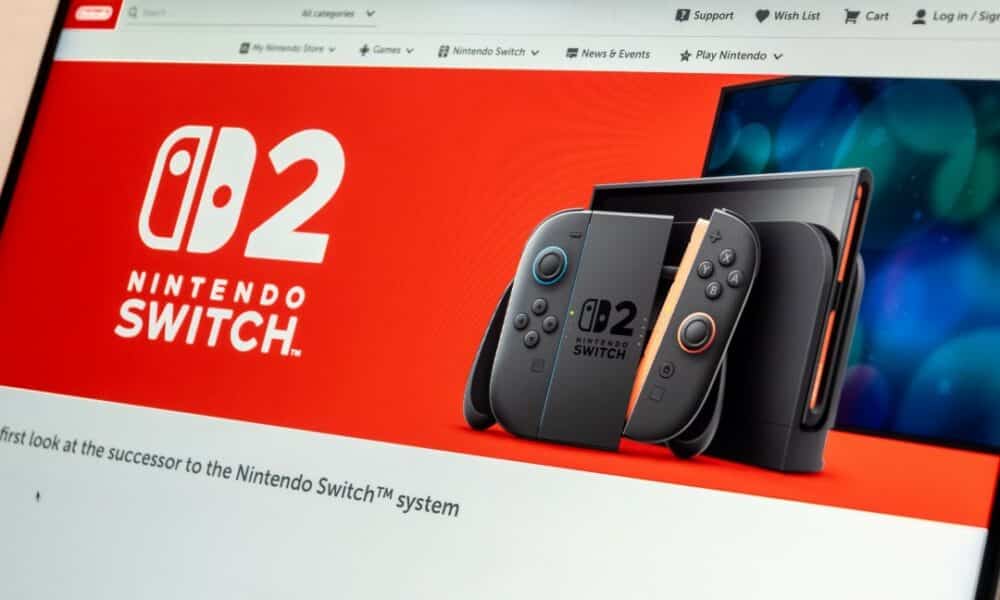Nintendo revealed long-awaited details about the Switch 2 on April 2, announcing its next-generation console set to hit stores on June 5 with a starting price of $449.99. The Nintendo Direct event showcased a device that retains the hybrid concept of its predecessor while introducing significant upgrades in hardware, design, and features. With over 150 million units sold since the original Switch launched in March 2017, the Japanese company is banking on enhanced power and a robust lineup of exclusive games to replicate that success. The console, succeeding the Switch after more than eight years, has already sparked excitement among gamers and investors, particularly with titles like Mario Kart World and Donkey Kong Bananza on the horizon.
The Switch 2 arrives with an 8-inch LCD screen, larger than its predecessor’s, and magnetic Joy-Cons designed for improved durability and ease of use. It also features an upgraded Nvidia chipset, delivering superior performance with 4K at 60 fps in docked mode and 1080p at 120 fps in optimized games. The June 5 launch date breaks from the traditional holiday season window, signaling Nintendo’s confidence in its brand and initial demand. Higher pricing reflects production costs and the impact of recent trade tariffs imposed by Donald Trump on countries like China and Vietnam, where the company shifted some of its manufacturing.
Analysts predict the Switch 2 could exceed 10 million units sold in its first year, driven by a loyal fanbase and backward compatibility with original Switch games, both physical and digital. Pre-orders begin April 9 in North America, with a special $499.99 bundle including Mario Kart World. The announcement also highlighted enhancements like 3D audio, HDR support, and a new interactive chat feature, free until March 2026 before requiring a Nintendo Switch Online subscription.
Revamped design and cutting-edge features
The Switch 2 preserves the hybrid essence that captivated the market but introduces notable design advancements. Its 8-inch screen offers 1080p resolution in handheld mode, a leap from the original’s 720p. Magnetic Joy-Cons eliminate mechanical wear concerns and aim to address the infamous drift issue that plagued many Switch users. The rear kickstand has been redesigned for greater sturdiness and adjustability, ensuring stability on various surfaces.
Additionally, the console boasts speakers with 3D audio support, enhancing immersion in games. Two USB-C ports—a first for the Switch lineup—expand connectivity options, while the updated dock supports 4K outputs. Storage capacity starts at 256 GB, expandable via microSD, and 12 GB of DDR5X RAM ensures smoother performance in demanding titles. These features position the Switch 2 as a competitive device, though it trails behind rivals like the PlayStation 5 and Xbox Series X in raw technical power.
Games set to drive sales
The Switch 2’s launch lineup stands out as a major highlight. Mario Kart World, exclusive to the new console, will retail for $80 digitally and $90 physically, signaling a trend of higher prices for AAA titles. Another confirmed release, Donkey Kong Bananza, arrives July 17 as the first platform-style entry in the series since Donkey Kong 64 hit the Nintendo 64 in 1999. Both games leverage the upgraded hardware, delivering high-definition visuals and optimized performance.
- Kirby Air Riders: Inspired by the GameCube’s Kirby Air Ride, this dynamic racing title is slated for 2025.
- Pokémon Legends: Z-A: A special edition for the Switch 2 with enhanced resolution and frame rates, launching late in the year.
- Hyrule Warriors: Age of Imprisonment: Developed with Koei Tecmo, this intense combat game debuts in winter.
These releases underscore Nintendo’s strategy of leaning on iconic franchises to draw consumers, while optimized versions of The Legend of Zelda: Breath of the Wild and Tears of the Kingdom gain visual upgrades and a new Zelda Notes feature tied to the Switch app.
Economic impact and market challenges
Priced at $449.99—higher than the original Switch’s $299.99 in 2017—the Switch 2 reflects both technological advancements and economic pressures. Production, now partly based in Vietnam after years in China, has been affected by Trump-era tariffs, raising costs. Experts note that Nintendo spent years optimizing its supply chain to reduce dependencies, yet external factors still influence the final price for consumers.
Still, initial demand is expected to be strong. Pre-orders, starting April 9, prioritize Nintendo Switch Online members in the UK, where the console will cost £395.99 (or £429.99 with Mario Kart World). Goldman Sachs analysts estimate Nintendo aims to sell over 10 million units in the first year, a bold target hinging on production capacity and game reception. Launching in June, outside the holiday season, suggests a reliance on brand strength and fan loyalty, with no need to wait for seasonal discounts.
Technology powering the Switch 2
At the core of the Switch 2 is a custom Nvidia chipset, offering “significantly improved” CPU and GPU performance, per Nintendo. While full specs remain under wraps, leaks point to an eight-core ARM Cortex A78C processor and 12 GB of LPDDR5 RAM. The console supports two modes: Quality Mode with 4K at 60 fps and Performance Mode with 1080p at 120 fps, both HDR-compatible. Dual internal fans, up from one in the prior model, ensure better cooling during extended play.
Backward compatibility is a key strength. Physical and digital Switch games will work on the new console, broadening its appeal for existing owners. Nintendo also confirmed Switch 2 integration with Nintendo Switch Online, adding GameCube classics like The Legend of Zelda: Wind Waker and Soulcalibur II for subscribers. These additions enhance the service’s value, which will charge for the interactive chat feature starting in 2026.
Fan and industry expectations
Gamers have responded enthusiastically, particularly to the promise of magnetic Joy-Cons and performance boosts. The larger screen and 4K support earned praise, though some expressed disappointment over the lack of an OLED option at launch. Nintendo hinted at repeating its past strategy, potentially releasing variants like an OLED edition later to extend the console’s lifecycle.
In the industry, the Switch 2 is a litmus test for Nintendo’s ability to stay relevant amid a market dominated by more powerful consoles. While PlayStation 5 and Xbox Series X prioritize cutting-edge graphics, Nintendo focuses on innovation and unique gameplay. The higher price sparked debate, but analysts believe the fanbase and exclusive franchises will ensure a strong start. With the launch just over two months away, anticipation is building for its retail performance.

Official Switch 2 timeline
The Nintendo Direct outlined the Switch 2’s schedule, providing a clear roadmap:
- April 9: Pre-orders begin in North America at participating retailers.
- June 5: Global launch at $449.99 (or £395.99 in the UK).
- July 17: Donkey Kong Bananza debuts as the first major post-launch exclusive.
- Late 2025: Pokémon Legends: Z-A and Kirby Air Riders arrive.
- March 2026: Interactive chat feature becomes subscription-based.
This timeline reflects Nintendo’s plan to sustain interest throughout the year with staggered releases and updates.
Features connecting players
A surprise highlight of the Switch 2 is its focus on connectivity. A built-in microphone with noise-canceling tech eliminates the need for external headsets in chats. Up to four players can share screens or join audio-only conversations, a feature free until March 2026. After that, it requires a Nintendo Switch Online subscription, which also includes classic games and exclusive perks.
The Zelda Notes feature, linked to the Switch mobile app, lets players jot down tips and share strategies in real-time while playing Breath of the Wild and Tears of the Kingdom. These additions highlight Nintendo’s push for a more social experience, aligned with online interaction trends, while retaining its signature solo gameplay focus.
Gearing up for a historic launch
With the Switch 2, Nintendo aims to replicate the triumph that made the original Switch its best-selling home console. Mass production is underway, and the company appears poised to avoid the shortages that marred its predecessor’s debut, worsened by supply chain disruptions. Initial stock is expected to meet the projected 10-million-unit demand in the first year, reflecting internal optimism and market expectations.
The higher price and lack of an OLED version at launch may pose challenges, but the blend of upgraded hardware, exclusive games, and backward compatibility should attract both newcomers and veterans. Opting for a June release over the holiday season underscores confidence in the brand and the buzz from the reveal. With pre-orders days away, the Switch 2 is shaping up as one of the year’s most anticipated gaming events.

Nintendo revealed long-awaited details about the Switch 2 on April 2, announcing its next-generation console set to hit stores on June 5 with a starting price of $449.99. The Nintendo Direct event showcased a device that retains the hybrid concept of its predecessor while introducing significant upgrades in hardware, design, and features. With over 150 million units sold since the original Switch launched in March 2017, the Japanese company is banking on enhanced power and a robust lineup of exclusive games to replicate that success. The console, succeeding the Switch after more than eight years, has already sparked excitement among gamers and investors, particularly with titles like Mario Kart World and Donkey Kong Bananza on the horizon.
The Switch 2 arrives with an 8-inch LCD screen, larger than its predecessor’s, and magnetic Joy-Cons designed for improved durability and ease of use. It also features an upgraded Nvidia chipset, delivering superior performance with 4K at 60 fps in docked mode and 1080p at 120 fps in optimized games. The June 5 launch date breaks from the traditional holiday season window, signaling Nintendo’s confidence in its brand and initial demand. Higher pricing reflects production costs and the impact of recent trade tariffs imposed by Donald Trump on countries like China and Vietnam, where the company shifted some of its manufacturing.
Analysts predict the Switch 2 could exceed 10 million units sold in its first year, driven by a loyal fanbase and backward compatibility with original Switch games, both physical and digital. Pre-orders begin April 9 in North America, with a special $499.99 bundle including Mario Kart World. The announcement also highlighted enhancements like 3D audio, HDR support, and a new interactive chat feature, free until March 2026 before requiring a Nintendo Switch Online subscription.
Revamped design and cutting-edge features
The Switch 2 preserves the hybrid essence that captivated the market but introduces notable design advancements. Its 8-inch screen offers 1080p resolution in handheld mode, a leap from the original’s 720p. Magnetic Joy-Cons eliminate mechanical wear concerns and aim to address the infamous drift issue that plagued many Switch users. The rear kickstand has been redesigned for greater sturdiness and adjustability, ensuring stability on various surfaces.
Additionally, the console boasts speakers with 3D audio support, enhancing immersion in games. Two USB-C ports—a first for the Switch lineup—expand connectivity options, while the updated dock supports 4K outputs. Storage capacity starts at 256 GB, expandable via microSD, and 12 GB of DDR5X RAM ensures smoother performance in demanding titles. These features position the Switch 2 as a competitive device, though it trails behind rivals like the PlayStation 5 and Xbox Series X in raw technical power.
Games set to drive sales
The Switch 2’s launch lineup stands out as a major highlight. Mario Kart World, exclusive to the new console, will retail for $80 digitally and $90 physically, signaling a trend of higher prices for AAA titles. Another confirmed release, Donkey Kong Bananza, arrives July 17 as the first platform-style entry in the series since Donkey Kong 64 hit the Nintendo 64 in 1999. Both games leverage the upgraded hardware, delivering high-definition visuals and optimized performance.
- Kirby Air Riders: Inspired by the GameCube’s Kirby Air Ride, this dynamic racing title is slated for 2025.
- Pokémon Legends: Z-A: A special edition for the Switch 2 with enhanced resolution and frame rates, launching late in the year.
- Hyrule Warriors: Age of Imprisonment: Developed with Koei Tecmo, this intense combat game debuts in winter.
These releases underscore Nintendo’s strategy of leaning on iconic franchises to draw consumers, while optimized versions of The Legend of Zelda: Breath of the Wild and Tears of the Kingdom gain visual upgrades and a new Zelda Notes feature tied to the Switch app.
Economic impact and market challenges
Priced at $449.99—higher than the original Switch’s $299.99 in 2017—the Switch 2 reflects both technological advancements and economic pressures. Production, now partly based in Vietnam after years in China, has been affected by Trump-era tariffs, raising costs. Experts note that Nintendo spent years optimizing its supply chain to reduce dependencies, yet external factors still influence the final price for consumers.
Still, initial demand is expected to be strong. Pre-orders, starting April 9, prioritize Nintendo Switch Online members in the UK, where the console will cost £395.99 (or £429.99 with Mario Kart World). Goldman Sachs analysts estimate Nintendo aims to sell over 10 million units in the first year, a bold target hinging on production capacity and game reception. Launching in June, outside the holiday season, suggests a reliance on brand strength and fan loyalty, with no need to wait for seasonal discounts.
Technology powering the Switch 2
At the core of the Switch 2 is a custom Nvidia chipset, offering “significantly improved” CPU and GPU performance, per Nintendo. While full specs remain under wraps, leaks point to an eight-core ARM Cortex A78C processor and 12 GB of LPDDR5 RAM. The console supports two modes: Quality Mode with 4K at 60 fps and Performance Mode with 1080p at 120 fps, both HDR-compatible. Dual internal fans, up from one in the prior model, ensure better cooling during extended play.
Backward compatibility is a key strength. Physical and digital Switch games will work on the new console, broadening its appeal for existing owners. Nintendo also confirmed Switch 2 integration with Nintendo Switch Online, adding GameCube classics like The Legend of Zelda: Wind Waker and Soulcalibur II for subscribers. These additions enhance the service’s value, which will charge for the interactive chat feature starting in 2026.
Fan and industry expectations
Gamers have responded enthusiastically, particularly to the promise of magnetic Joy-Cons and performance boosts. The larger screen and 4K support earned praise, though some expressed disappointment over the lack of an OLED option at launch. Nintendo hinted at repeating its past strategy, potentially releasing variants like an OLED edition later to extend the console’s lifecycle.
In the industry, the Switch 2 is a litmus test for Nintendo’s ability to stay relevant amid a market dominated by more powerful consoles. While PlayStation 5 and Xbox Series X prioritize cutting-edge graphics, Nintendo focuses on innovation and unique gameplay. The higher price sparked debate, but analysts believe the fanbase and exclusive franchises will ensure a strong start. With the launch just over two months away, anticipation is building for its retail performance.

Official Switch 2 timeline
The Nintendo Direct outlined the Switch 2’s schedule, providing a clear roadmap:
- April 9: Pre-orders begin in North America at participating retailers.
- June 5: Global launch at $449.99 (or £395.99 in the UK).
- July 17: Donkey Kong Bananza debuts as the first major post-launch exclusive.
- Late 2025: Pokémon Legends: Z-A and Kirby Air Riders arrive.
- March 2026: Interactive chat feature becomes subscription-based.
This timeline reflects Nintendo’s plan to sustain interest throughout the year with staggered releases and updates.
Features connecting players
A surprise highlight of the Switch 2 is its focus on connectivity. A built-in microphone with noise-canceling tech eliminates the need for external headsets in chats. Up to four players can share screens or join audio-only conversations, a feature free until March 2026. After that, it requires a Nintendo Switch Online subscription, which also includes classic games and exclusive perks.
The Zelda Notes feature, linked to the Switch mobile app, lets players jot down tips and share strategies in real-time while playing Breath of the Wild and Tears of the Kingdom. These additions highlight Nintendo’s push for a more social experience, aligned with online interaction trends, while retaining its signature solo gameplay focus.
Gearing up for a historic launch
With the Switch 2, Nintendo aims to replicate the triumph that made the original Switch its best-selling home console. Mass production is underway, and the company appears poised to avoid the shortages that marred its predecessor’s debut, worsened by supply chain disruptions. Initial stock is expected to meet the projected 10-million-unit demand in the first year, reflecting internal optimism and market expectations.
The higher price and lack of an OLED version at launch may pose challenges, but the blend of upgraded hardware, exclusive games, and backward compatibility should attract both newcomers and veterans. Opting for a June release over the holiday season underscores confidence in the brand and the buzz from the reveal. With pre-orders days away, the Switch 2 is shaping up as one of the year’s most anticipated gaming events.







